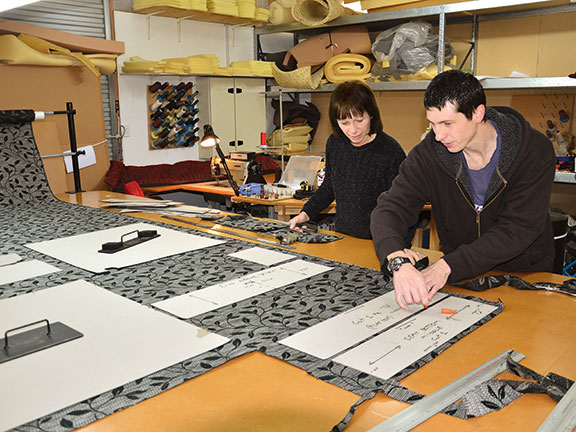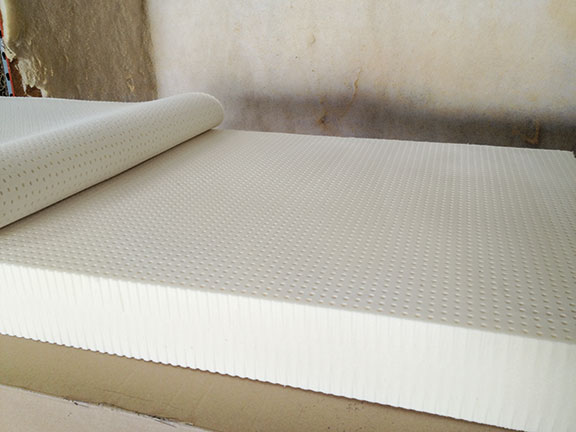The mantra for selecting RV upholstery is a simple trinity: durability, ease of cleaning and colourfastness. And a major part of the selection process is likely to be shaped by the type of upholstery. There are three basic ones: vinyl, leather and fabric. Each has pros and cons.
Vinyl: Exceptionally durable, and very easy to clean. It's perfect for RV owners travelling with sticky-fingered children and/or dirty-pawed pets, when touring is often dictated by the 'least-hassle' approach. But vinyl is sweaty and clammy in summer (and cold in winter) and the colour/texture/pattern range is limited.
Leather: It's plush, looks very classy, and almost everyone likes the smell — although some would argue it's too staid and formal for a motorhome. It's also fairly expensive and because it dries out quickly it demands regular maintenance and cleaning with specialised products. The range of colours and textures is also fairly limited.
Fabric: A treasure trove of colours, designs, patterns — but be wary. Quality varies considerably. Depending on the raw material and manufacturing process, some fabrics are tougher and more durable than others. Some are easier to clean than others.
In addition, the fabric segment is further divided into two by raw material. Natural fabrics include cotton, wool, linen and rayon — their synthetic cousins include polyester, nylon, acrylic, olefin and microfibre. Again, each has pros and cons.
Choosing between them requires careful assessment and, with that in mind, I asked Tony Beach, sales manager at Auckland's Warwick Fabrics, for a few guidelines to help me in the selection process. The company is a major distributor of vinyl, leather and fabric for upholstery.
Some 90 percent of the New Zealand RV market opts for fabric upholstery, Beach estimates, and durability and robustness are always prime considerations. "If you're going to the trouble and expense of revitalising your motorhome's interior with a re-upholstery project, you may as well invest in a fabric that's going to last.
"A motorhome can be a tough environment for upholstery — people sit, sleep and eat around the same surface, so the wear and tear is significant, with a high risk of spills and other damage. At the very least you should be opting for a commercial-grade or even a heavy-commercial fabric that has built-in stain-resistant properties. A less-expensive, domestic- or light-grade product will simply need to be replaced sooner."
Assuming your creative flair leans towards a fabric rather than vinyl or leather, says Beach, a number of factors could shape your final selection.
Natural or synthetic?
For organically-minded RV owners, fabrics manufactured from natural fibres may hold an obvious appeal. But there could be a downside.
"As a general rule, synthetic fabrics are more colourfast and will retain their look and feel for longer than the natural alternatives," says Beach. "They are also less susceptible to pilling.
"But the real benefit of a synthetic fibre is the absence of joins. Where natural yarns are spun from short fibres to create a base weave, synthetic fibre is made from a continuous monofilament. Its no-join structure provides enormous strength.
"Previously, the disadvantage of synthetic fibres was their harder feel and, compared with natural fabrics, their relatively unforgiving texture. But today, with technological advances, we have synthetic fibres and fabrics that are softer than their natural alternatives."
He also points out that while vinyl is very easy to clean, modern manufacturing processes have delivered fabrics that are as resistant to staining, and as easy to clean, as vinyl.
Warwick's extensive range of Halo fabrics, for example, are high-performance, low-maintenance products. Completely synthetic, they have built-in stain-resistant properties. Beach says it's like having a fabric with a live-in guardian angel, hence the Halo title.
Patterns
In addition to 'lifting' a motorhome's interior, an astute choice of design can enhance or detract from the sense of space. Vertical stripes, for example, will make a motorhome look taller but narrower. Be wary, says Beach, of complex designs and geometric patterns.
"Geometric patterns are very difficult to 'bend' around corners — and rounded back rests are particularly problematic. A small, uniform pattern doesn't distort in the same way as a large, loud pattern."
Allergies
If you suffer from allergies or asthma (and with New Zealand's climate, thousands of us do) it might be worth considering a fabric that's resistant to mould and mildew and is specifically treated to minimise pests such as dust mites, moths and silverfish.
Warwick, for example, carries a Macrosuede Healthguard™ range of fabrics. The manufacturing process is complex (so the fabric is expensive and the range more limited), but an allergy-neutral fabric can be a major blessing for chronic sufferers.
UV protection
Bear in mind that no fabric is 100-percent colourfast and it's impossible to prevent colours fading. Most fabrics are UV-treated to minimise sun damage, but to preserve your upholstery use the RV's blinds and curtains and rotate the position of any loose curtains regularly to extend their life, as well as the general seating area.
What's inside?
While a striking fabric may look cool on your settee, ensuring the settee's also comfortable comes down to what you choose to put inside. Popular options includes polyurethane foam or latex.
An example of the former is Dunlop's Elephant Foam. Widely used by upholsterers, it's available in various thicknesses (125mm to 150mm is ideal) and in densities ranging from 33kg/m3 — 41kg/m3.
As a natural product, latex (harvested from rubber trees) may appeal to the organically-minded RV owner. It has a reputation for superior elasticity and for resisting mildew and shunning allergy-aggravating pests.
If you're tired of hiding that old Worcester sauce stain on your settee behind a cushion, or fed up with trying to retrieve loose change from inside the torn mattress cover, it might be time to visit an upholstery store.
But before homing in on a colour, think function and form: practicality, durability and, above all, ease of cleaning.

Event preview: NZMCA Motorhome, Caravan & Leisure Show 2025
The NZMCA Motorhome, Caravan & Leisure Show returns to Wolfbrook Arena in Christchurch later this month, with doors opening on








